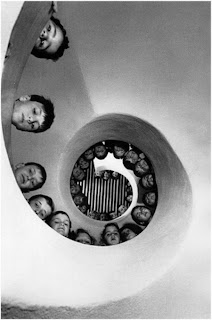Kertez and Cartier-Bresson vs smith and salagado
Andre Kertesz was an amazing Hungarian photojournalist who took his
first serious photographs in the First World War. Kertez focused on the lives of soldiers not
fighting instead of concentrating more on the war aspect. He was said to have a knack for grabbing the
seemingly unimportant and subtle moments.
Even though the amazing work and the contribution to the evolution of
the art of photography he was overlooked his whole life due to him not commenting
on his subjects.
Kertesz like Henri Cartier-Bresson was a soldier and contributed in
photojournalism. Cartier- Bresson was
born in France and is known as the father of modern photojournalism. He was a master of candid photography and
helped develop the Street Photography / Life Reportage style in
photography. Cartier-Bresson was
inspired by Kertesz and cited him few times saying “we all awe him a great
deal”. He also was greatly drawn to the surrealist movement. Martin Munkacsi’s photograph “three boys at
Lake Tanganyika” in 1930 attracted him towards photography. Cartier-Bresson liked anonymity and went to
great lengths to maintain it. He is said
to have painted the shiny parts of his camera black. He never used flash in his photography because
he compared it with bringing a gun to a concert. Henri Cartier-Bresson always dismissed
others’ applications of the term “Art” to his photographs.
Sabastiao Salagado is a Brazilian social documentary photographer and
a photojournalist. He is one of the most
respected photojournalist working today.
He is well known to show dignity towards his subjects. Mr. salagado’s respect for his subjects and
his determination to draw out the larger meaning of what is happening to them,
has created an imagery that testifies to the fundamental dignity of all
humanity while simultaneously protesting its violation by war, poverty and
other injustices.
W. Eugene Smith was a legendary American photojournalist. He was well
known for his vivid World War II photographs and a stubborn personality for
refusing to follow the professional standards of photojournalism. Smith spent most of his career taking
pictures of the war and traveling to major countries of the world and capturing
milestone events with his camera.
All four of these photojournalists spent major part of their lives
capturing the world turning events and contributing their experiences to the
art of photojournalism and photography in general.
Photograph by: Andre Kertesz
Photograph by: Henri Cartier-Bresson
-What are the main differences and similarities?
Andre Kertesz tended to capture life that’s happening around him.
Although Kertesz could not recognize himself having a photojournalistic nature,
he was born with it. His work tells the stories as they happened. He had a
natural ability to capture realities in the perfect moment.
Henri Cartier-Bresson, one of the founders of Magnum Photos, believed
that the main role of photojournalists is reporting. Unlike journals written in
text, Cartier-Bresson thought that photojournalism should not take someone’s
point of view and the audience should accept the pictures as they are without
analyzing them.
Eugene Smith was one of unique photojournalists in a way that he tried
to get involved in his work and directly influenced the product while most
photojournalists avoided interacting with people they photographed in order to
have reporter’s objectiveness. Smith even edited his photos to exaggerate what
he wanted to tell through pictures.
Sebastiao Salgado was also a photojournalist who interacted with the
people in his photographs. He was more like an opinion writer, not a reporter.
Salgado also used a lot of postproduction in his photographs making people who
were suffering look beautiful.
Andre Kertesz and Henri Cartier-Bresson had similar photojournalistic
styles. They both thought that they need to be invisible when they are taking
pictures so that scenes are not interrupted. They told the stories as they
happened, and those stories are just found from their surroundings. In
addition, they took no point of view in order for the audience to see their
photographs as they are.
On the other hand, Eugene Smith and Sebastiao Salgado had a similar
style from each other, but it was very different from Kertesz’s and
Cartier-Bresson’s. Smith and Salgado both entered the circle being a part of people
in their photographs. They believed that it is the way to understand people’s
feelings, which can be expressed on their pictures. For instance, Smith even
lived with others for about a month before taking pictures. Furthermore, Smith
and Salgado applied their opinions to photographs. To do that, they composed
and underwent postproduction process. Smith tended to exaggerate what he wanted
to show by lighting, and Salgado altered his work such that suffered people
look beautiful.
- What’s the better journalistic approach?
I don’t think there is any better journalistic approach among these
legends. But, I do prefer the approach
use by Andre Kertesz and Henri Cartier-Bresson who stayed invisible and
anonymous and refused to alter their images for they might drift away from the
journalistic idea.
--Group work.
--Team members:
Mary Jane P. Cortez
Xin Wang
Jun Hee Hong
Vrindar Banker (me)




















